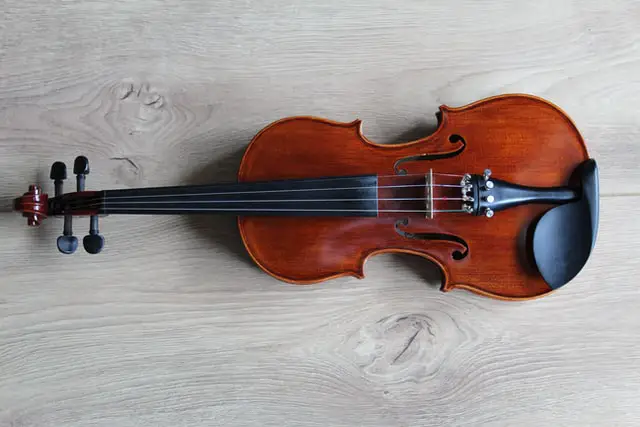In this article, we will rate string instruments in order of complexity from most difficult to least difficult. The following is a list that we have painstakingly constructed.
The basic premise of string instrument operation is that sound is propagated by vibrating the strings in a specific pattern. To make the desired sound, these strings are vibrated using the finger or a plectrum. String instruments have different levels of difficulty depending on their construction, design, and functioning mechanism.
5 Most Difficult String Instruments
1. Violin

According to our study, the violin is by far the most difficult string instrument to master. The violin is made up of only four strings and has a very simple construction.
Surprisingly, it remains the most difficult string instrument to master. We will start with the tuning to see why the violin is regarded as the most difficult instrument to master. Unlike the guitar, the violin has no specific fret or finger location that might assist beginners in determining where to lay their fingers.
Instead, the proper finger posture is learnt by trial and error and under the guidance of a professional or talented violin teacher. Beginners will find it difficult to play in tune because of this.
Speaking of posture, violin players have a distinct posture that they adopt while playing the instrument. While learning how to properly hold and place the violin can take a long time and may not be comfortable for a beginner at first, it is the first and most basic step in learning to play the violin. Maintaining proper posture and learning how to handle the violin are requirements for good violin use.
You will also need to figure out the best bowing technique for you. It is not as simple as it sounds; it takes some time to bow while maintaining flawless sight-reading accuracy. Because the violin’s strings are so close together, it is difficult for beginners to figure out which one to play at any one time.
Add the right hand bow movement on top of the left hand shifting and fingering action to get a clear image of how tough the violin is to master, and you will notice that you will have trouble with hand-eye coordination. The violin is the most difficult instrument to learn for a variety of reasons, including the fact that it might take years of constant practice to achieve a pleasing sound.
2. The Harp
![]()
There is no denying that when played by skilled harpists, harps make a wonderful sound. While the sound is beautiful, learning to play the harp is not for the faint of heart.
A conventional harp, for example, contains a whopping forty-seven strings that must be plucked with extreme precision. That sounds incredible, right? With the harp, there is a lot of plucking to be done. To be able to play all of the strings and reach all the essential notes, the harpist must have flexibility, speed, and endurance.
The pedals on harps are used to sharpen and flatten the notes, respectively. They add to the difficulty because they are grouped together. Having solid muscle memory skills is probably the only thing that will make playing the harp a little easier for you.
3. ZIther

The zither is a handcrafted string instrument that pairs beautifully with both the piano and guitar. The zither is not as easy to play as other melodic string instruments, despite its popularity.
One reason is that finding a professional zither tutor is not always easy. Learning to play the zither takes a lot of effort and dedication; if you want to be perfect at it, you need to set up at least one hour each day to practice.
You must be able to play the zither by ear as well as read music in order to perform it. The majority of zither sounds are written in one of two clef systems: the Munich clef system, which uses treble clefs for both the top and bottom staves, or the Viennese clef system, which uses treble and bass clefs for the top and bottom staves, respectively.
The zither’s fingerboard is fretted using the finger. The right hand plays the button staf, which contains the accompaniment, as well as the bass and contrabass strings. Learning how to play the clef system and how to play with both hands efficiently is a key challenge for zither players.
4. Guitar

The guitar is a tremendously popular instrument all throughout the world, and it may be found in practically every musical setting or performance. The guitar has been around for a long time and can be used to perform alternative, country, jazz, rock, and other types of music. Although the guitar is simple to play, it is tough to learn and master.
Their instrument is well-known for having frets, which make it simple to play precise notes. If you do not have any problems with finger coordination or positioning, the guitar should be easier to play for you.
Mastering the chords, rhythm, and timing required to play the guitar is the most difficult part. It can take a long time to become a proficient guitarist.
The chords, in particular, are more difficult for beginner players who are used to playing solo notes on other string instruments.
Sight-reading is another part of the guitar that is frequently disregarded. Sight reading while playing the guitar is actually rather difficult. This is another reason why most bands begin in garages, where they rehearse and discipline for many hours in order to play a harmonious tone.
5. Ukulele

In our list of the most difficult string instruments, the ukulele is the string instrument with the least amount of difficulty. The ukulele is a tiny stringed instrument with a wooden body. The ukulele, which is made of tonewood and has four nylon strings, is strummed with the fingers or a pick by performers.
The ukulele, like the guitar, has a hardwood neck with horizontally positioned metallic frets that may be used to produce various pitches.
The ukulele is not difficult to play; rather, small complications occur from the ukulele’s placement. Most People find it difficult to hold due to its small size.
In addition, the ukulele only has four strings that may be tuned in fourths. Making a particular ukulele sound is partly dependent on the instrument’s tuning, and changing that tuning would lessen the unique features of the instrument, which can be a bit difficult for beginners to learn.







